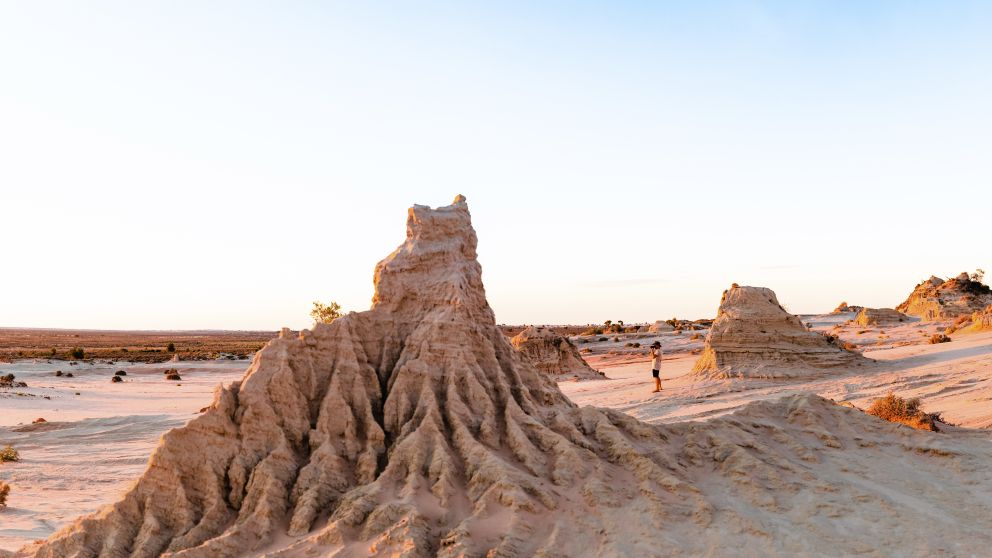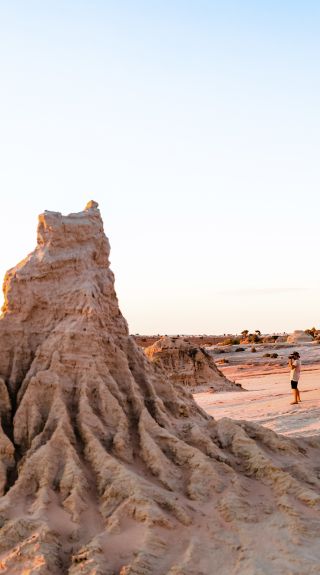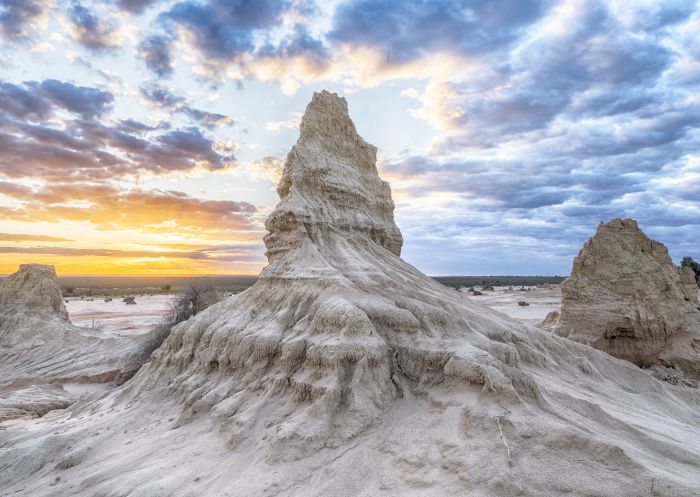

Slow down & connect with the land in the Riverina and Murray regions
Walls of China, Mungo National Park. Image Credit: Tyson Mayr


Destination NSW
Arriving in Mungo National Park in a remote part of southwestern NSW, you’d be forgiven for thinking you’d landed on an alien planet. Once a fertile lake that supported abundant human life and prehistoric giant mammals, it dried up at the end of the ice age, creating a surreal landscape painted in bleached pastels. From the clay pans that have been eroded by wind and rain over thousands of years, gnarled, fluted pillars rise towards the sky known as the Walls of China, the remains of ancient sand dunes named for the Chinese workers who built a shearing shed nearby in the 1800s.
Easily the best way to navigate this magnificent destination is on the guided Mungo Walk the Walls of China Tour with an NPWS Aboriginal Ranger. With some over 40 metres in height, the astonishing pinnacles stretch in an arc for over 40 kilometres. You’ll learn about the immense cultural significance of this World Heritage-listed area, including the discovery of the 42,000-year-old remains of the Mungo Lady in 1968 and the Mungo Man in 1974. Found in a dried lakebed in the heart of the park, Mungo Lady and Mungo Man proved without dispute that Aboriginal people have walked these lands for tens of thousands of years.
After soaking up an incredible sunset, head to Mungo Lodge and spend a night or two in one of their comfortable cabins, which are furnished with local artwork, or at an unpowered campsite with nearby amenities block. Or for something different, discover the area’s pastoral history at the heritage Mungo Shearers’ Quarters, which is a great option for families and groups.

Walls of China, Mungo National Park
As you stand quietly and tune into your surroundings, you’ll start to notice every little sound: the splash of a musk duck or the elegant swoop of an eastern great egret as it searches the waters for its next meal. In the Riverina region near Deniliquin, the Reed Beds Bird Hide Boardwalk at Mathoura is a haven for birdwatchers, surrounded by the towering red gums that Murray Valley National Park is famous for. An easy stroll along the boardwalk – which is lined with informative panels about the myriad species you can spot – this is a place where you can sit with your binoculars and gaze at the unique wetland environment for hours.
Darting among the trees, the yellow rosella (also known as the yellow-rumped parrot) is one of the other feathered locals you are likely to spot here. Unique to the Murray region, its sunshine feathers are a bright flicker between the trees, and their noisy chatter is a symbol of the area. Also in their company are the aptly named superb wren, the purple swamp hen and the humble goose. Be sure to bring your camera and enjoy composing the perfect shots to remember this magical experience by.
Near Wagga Wagga in the heart of the Riverina, The Rock Nature Reserve – Kengal Aboriginal Place has a dual name that reflects a significant Wiradjuri cultural presence. Though the reserve may be small, it is rich in diversity, with numerous habitats to be explored and much history to be unearthed. The best way to discover this special place is with Bundyi Cultural Tours. Over the course of half a day, your guide will unveil Wiradjuri culture, language and story, helping you form a deep and lasting connection to “Ngurambang” (pronounced nurambung – the Wiradjuri word for Country).
If you’re a keen hiker, make time to climb to the top of the namesake of this reserve. Soaring 364m above the plains, The Rock is a geographical formation completely unique in the area, the highest point of a hogback ridge running north to south among otherwise rolling flat farmland. From its summit, you’ll marvel at the diverse landscapes it straddles – on one side, the Riverine Plains, and on the other, the western slopes of the Eastern Highlands, all the while inhaling the freshness of gum tree flowers.

Kengal Aboriginal Place, Wagga Wagga
With 2000ha of richly varied landscapes and opportunities to mountain bike, horse ride, 4WD or camp, Livingstone National Park near Wagga Wagga has something for everyone. The 4.3km multi-use loop track is a great place to start: trot, stroll or ride through the peaceful forests of towering cypress pines, scribbly gums, wattle and grass trees. The track is short but full of surprises: the calls of threatened native birds such as the turquoise parrot and hooded robin, and the rustle of a wallaby or wombat making their way home. A visit in spring sees the forest come alive with bursts of wildflowers – including bright yellow kangaroo thorn and everlastings, which punctuate the open woodlands with their captivating blooms.

Livingstone multi-use loop track, Livingstone National Park - Credit: Rob Mulally, DPE
Stay safe in NSW national parks. Plan by checking the NPWS website for alerts and closures before visiting a park. For more safety tips and park alerts, visit nationalparks.nsw.gov.au/safety.
Subscribe to our newsletter in order to stay up to date for all the upcoming events, news and inspiration.
Never miss out on news and events
All the insider news, tips and inspiration you need to plan your next trip, delivered straight to your inbox.
Sign UpVisitNSW.com is the official tourism site for Destination NSW.
© Copyright 2024 Destination NSW. All rights reserved